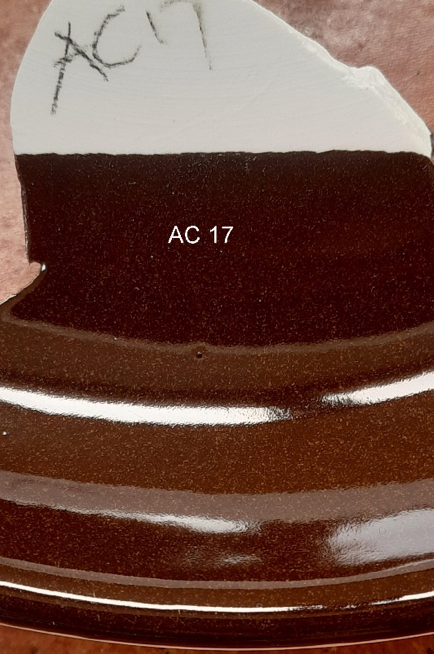Hi Potters
I have been using Abbots Clear as a source of boron in more and more of our production glazes lately – you know – the Temuka Pottery and The Alchemist’s Table glazes.
This got me thinking that many, many Cone 6 glazes can be built on an Abbots Clear base. My first, and somewhat rushed set of results, shown below, is a little underwhelming but I will keep at it and share the data as I go.
The series of glaze tests below (AC1 to AC19) start off with 100% Abbots Clear and then I let my imagination take over. This is my approach to glaze development!
AC1 This is 200g of Straight Abbots Clear, with this formula:
I have been using Abbots Clear as a source of boron in more and more of our production glazes lately – you know – the Temuka Pottery and The Alchemist’s Table glazes.
This got me thinking that many, many Cone 6 glazes can be built on an Abbots Clear base. My first, and somewhat rushed set of results, shown below, is a little underwhelming but I will keep at it and share the data as I go.
The series of glaze tests below (AC1 to AC19) start off with 100% Abbots Clear and then I let my imagination take over. This is my approach to glaze development!
AC1 This is 200g of Straight Abbots Clear, with this formula:

Great result!
We know that Abbots Clear fires as low as Cone 3, so to extend its firing range I have added other stuff (I won’t show them all).
We know that Abbots Clear fires as low as Cone 3, so to extend its firing range I have added other stuff (I won’t show them all).
Here is AC4
Added so far: 10g New Zealand China Clay, 25g Potash Feldspar, 20g Silica, all easily diluted in
original glaze and here is the formula:

So – with lower boron, low (maybe too low) COE and higher silica and alumina this will work nicely as a cone 6 glaze.
AC5. Time to add some colour – 6g of Abbots RT123 Cobalt Silicate stain.

AC11 – note everyone just wants a glossy clear glaze so let’s keep adding! 50g potash feldspar, 15 dolomite, 15g NZCC, 5 rutile and 20 silica.
The Formula:
The Formula:

Expansion is up a bit, Boron is ever reducing and Alumina and Silica generally on the increase and with a falling Si/Al ratio. Note the image shows the pigment diluted and a more milky glass.
There is no reason to stop exploring – add more stuff: this time: 15g dolomite, 20 silica, 5 red iron oxide and 5 rutile. Here is the formula For AC15:
There is no reason to stop exploring – add more stuff: this time: 15g dolomite, 20 silica, 5 red iron oxide and 5 rutile. Here is the formula For AC15:

I really like what is starting to happen here – an earthy colour with a blue speckle developing. These will be due to the modest rutile additions. The glaze has a pitted surface. In part 2 of this development I will take this version of the glaze – AC15, and vary the dolomite to see where it takes us.
So – nearly done – now explore adds of 4g tin and 5g iron oxide to create AC17. Iron and tin are both refractory and have given the glaze a smoother surface – still with the subtle speckle.
So – nearly done – now explore adds of 4g tin and 5g iron oxide to create AC17. Iron and tin are both refractory and have given the glaze a smoother surface – still with the subtle speckle.


